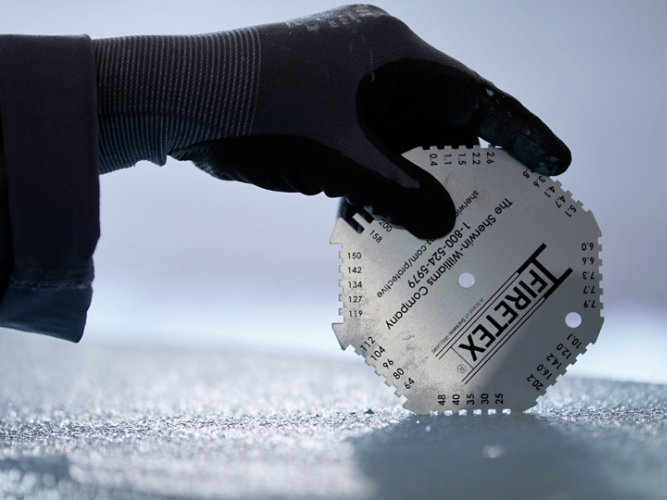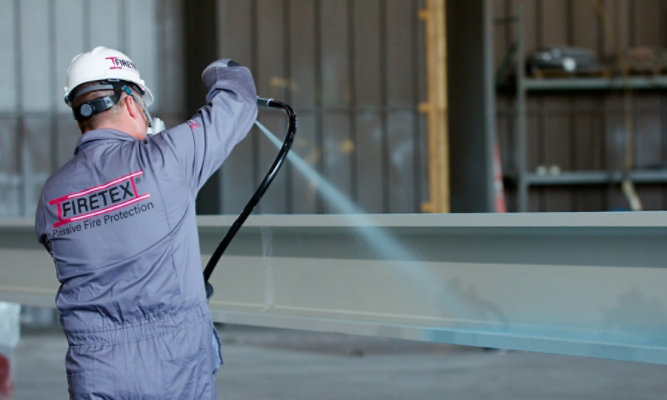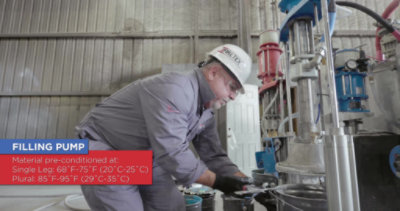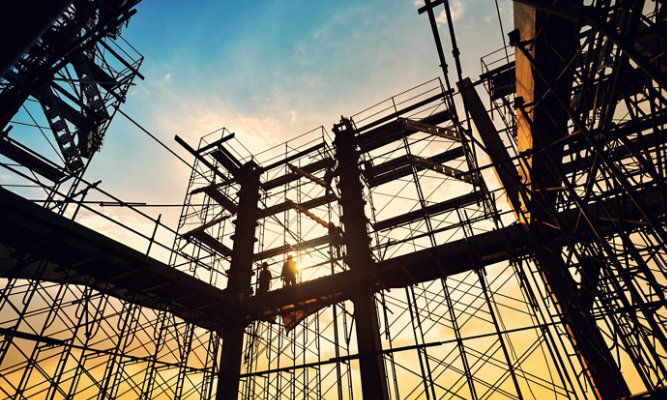Calling for a New Finish Standard for Intumescent Cellulosic Fire Protection Coatings on Architecturally Exposed Structural Steel (AESS)
The Need to Standardize AESS Guidelines for the Appearance of Intumescent Fire-Resistive Materials (IFRMs)
by Max Tritremmel, Global Fire Protection Market Segment Director, Sherwin-Williams Protective & Marine

IFRMs Introduce a Sleeker Appearance for AESS
Architecturally Exposed Structural Steel (AESS) (Figure 1) is a popular design feature that can express both the strength and beauty of steel as a complement to other architectural features. However, as a key part of what provides the integrity of the structure, that steel must be protected to ensure it retains its strength in the event of a catastrophic fire. Traditional fire protection materials were Sprayed Fire-Resistive Materials (SFRMs), commonly referred to as cementitious fire protection, that were not well suited to complement the beauty of exposed steel. These unsightly finishes often required concealment in the form of drop ceilings, sheetrock or covers to ensure architects could meet their aesthetic design objectives. The advent of Intumescent Fire-Resistive Materials (IFRMs), which are smooth in appearance, finally allowed for that expression of exposed steel in new and creative ways, and new material innovations continue to support that change. IFRMs allow designers to strip away the unnecessary elements that were common to construction over the last 100 years and create new, simpler buildings that can be delivered with greater speed, total cost efficiency and sleeker appearances.
Given the emphasis on beauty with AESS, it is problematic that no single global standard exists for specifying the finish appearance of the IFRM coating for this defining element in building design. After all, the American Institute of Steel Construction (AISC) offers a detailed category system for specifying the overall finish quality of exposed steel, based on member visibility, viewing distance, location, lighting, coatings, style and adjacency, but also importantly, cost.1 However, the AISC guidelines make only minimal reference to IFRM coatings in the AESS category system, referring to these coatings, generally, as “smooth.” Establishing better guidance than “smooth” for the appearance of IFRMs on exposed structural steel will help the construction and coatings industries deliver better outcomes for AESS that’s meant to be seen and admired by the public.
Current IFRM Finish “Standards” for AESS Leave Room for Doubt
Historically, the fire protection industry has concerned itself with performance, defined by code compliance, rather than finish. Architects and contractors are also responsible for the look and finish quality of AESS surfaces in addition to compliance with those codes. In the absence of a defined coating standard for the appearance of IFRMs applied to AESS, they have no really objective or straightforward ways to define, in advance, the look of an AESS finish that will ensure acceptance by the building owner.
With no overarching standard to reference, some architects initially turned to makeshift standards such as the GA-214-2021, Levels of Finish for Gypsum Panel Products2 guidelines. This made sense when considering the adjacent role of gypsum wallboard in fire containment and the interaction of it in wall systems when attaching to and encasing SFRMs. While GA-214-2021 may provide a useful analogue for finish quality, the materials, processes and tools used to apply gypsum-based products are quite different from those used with IFRMs applied to exposed steel surfaces and, ultimately, the correlation was poor with the desired outcomes often being off the mark.
Figure 1. Intumescent Fire-Resistive Materials (IFRMs) (shown) offer an attractive, architecturally pleasing finish compared to bulky cementitious Sprayed Fire-Resistive Materials (SFRMs), enabling the use of Architecturally Exposed Structural Steel (AESS) throughout buildings.
Figure 2. The type and thickness of the IFRM used on AESS influences the texture of the final finish, with epoxies (shown) having a thicker, more textured appearance than water- and solvent-based acrylic intumescents.
In Europe, where IFRMs have surpassed SFRMs in cellulosic fire protection applications, the guidance is a bit more advanced and closer to the mark. The Association for Specialist Fire Protection (ASFP) Technical Guidance Document 16, Code of Practice for Off-Site Applied Thin Film Intumescent Coatings3, outlines three categories of finish – Basic, Decorative and Bespoke – and promotes cost-saving, off-site IFRM applications so that pre-coated beams arrive at the jobsite ready for assembly. This standard is a dramatic improvement over the use of the AWCI/GA 214 Standard. It is built to cater to IFRMs including application variations such as orange peel, which a drywall standard would not. It also considers observer distance, which will be critical to helping identify when the use of the standard is appropriate. However, the use of this standard is problematic for several reasons. First, the description in Paragraph 2 of a Decorative Finish is largely subjective and may lead to dispute in the field on cost impact and remedial work to achieve a “good standard of cosmetic finish.” It would also rely on the bespoke finish for all critical items in close view (AESS categories 3 and 4). Commercially, this is an issue for hard bid work, as the concept of a bespoke finish agreed in the field lends itself more to design build arrangements due to its inherent ambiguity. A contractor may have issue with providing an effective bid for an item for which its level of effort would likely be determined post-award.
In the absence of an objective, industry-accepted standard, coatings manufacturers, applicators, architects and building owners continue to struggle with all of the basic questions – material selection, application and finishing procedures, appearance standards, and more. And, with no allegiance to a single standard, there remains considerable room for subjectivity, bias and costly disagreement over the finish quality of coated AESS members. Ideally, an appearance standard for IFRM coatings would be built to align with the AISC’s AESS categories and their specific surface quality requirements.
IFRM Materials, Formulation, Application and Finishing Criteria
Any workable global IFRM finish standard for AESS must address the three generic types of IFRM coating materials: water-based acrylic, solvent-based acrylic and plural-component intumescents. The comparisons found in Tables 1 and 2 highlight key features of these material types and suggest how material capability, formulation, application, dry time and service environment influence material selection and finish. In general:
- Both water- and solvent-based acrylic intumescent systems apply in thinner coats than epoxies– typically 30-60 mils dry film thickness (DFT) – making them more likely to self-level into smoother finishes. In addition, their lower viscosity enables the use of finer spray tips, resulting in better atomization and a more aesthetic finish. Acrylic intumescents are typically well suited to interior, general-purpose and conditioned spaces. They may also be used on some exteriors with the help of a topcoat to protect the fire protection coating from atmospheric degradation.
- Epoxy intumescents are applied in thicker films (typically around 100 mils DFT or more), but their thixotropic nature makes for a more textured or “orange-peeled” finish (Figure 2). Epoxies provide the best overall long-term performance, especially in corrosive, physically demanding or severe exterior environments, giving them a substantial life cycle cost advantage over acrylics in these applications. They also lend themselves to offsite application, making them ideal for new construction projects, particularly for AESS-2 designs.
Table 1. Key Characteristics of IFRM Coating Types
| Water-Based Intumescent | Solvent-Based Intumescent | Epoxy Intumescent | |
|---|---|---|---|
| Initial Appearance | Water-Based Intumescent Smooth | Solvent-Based Intumescent Fine texture | Epoxy Intumescent Moderate texture |
| Application Equipment | Water-Based Intumescent Simple | Solvent-Based Intumescent Simple | Epoxy Intumescent Moderate to complex |
| Number of Coats | Water-Based Intumescent Multiple thinner coats | Solvent-Based Intumescent Multiple thinner coats | Epoxy Intumescent Fewer thicker coats |
| Odor | Water-Based Intumescent Low | Solvent-Based Intumescent High | Epoxy Intumescent Variable based on solvent package |
| Dry Time/Recoat Time | Water-Based Intumescent Slow | Solvent-Based Intumescent Slow | Epoxy Intumescent Fast |
| Application/Curing Environment | Water-Based Intumescent General 50-100°F (10-38°C), less than 80% RH | Solvent-Based Intumescent General 41-110°F (5-43°C), up to 85% RH | Epoxy Intumescent Generally, 41-110°F (5-43°C), up to 85% RH |
| On- or Off-Site Application | Water-Based Intumescent Usually on-site in conditioned environments | Solvent-Based Intumescent Usually on-site in temperate atmostpheric environments | Epoxy Intumescent Both, although strongly favored in off-site application |
| Service Environment | Water-Based Intumescent Generally, for interior conditioned spaces, but can also be used for interior general purpose and mild exterior service spaces with topcoats | Solvent-Based Intumescent Generally, for interior conditioned spaces or interior general purpose spaces, but can also be used for mild exterior service spaces with topcoats | Epoxy Intumescent Suitable for all environments including severe physical, chemical or atmostpheric environments |
Table 2. Advantages/Disadvantages of IFRM Coating Types
| Material Type | Advantages | Disadvantages |
|---|---|---|
| Material Type Water-Based Intumescent |
Advantages
|
Disadvantages
|
|
Material Type
Solvent-Based Intumescent |
Advantages
|
Disadvantages
|
|
Material Type
Epoxy Intumescent |
Advantages
|
Disadvantages
|
While performance requirements and material composition are strong influencers on IFRM coating finishes, three other issues can also play a vital role in IFRM finish quality, including: product formulation, application techniques and secondary shaping, such as using rasps and sanding. The level of finishing, such as troweling and finish rolling, affect the finish quality as well, along with DFT requirements, as coatings with higher DFTs tend to be rougher and or wavy in appearance.
IFRM Formulation
Finish-related factors in formulation include variables such as fiber content and length, pigment selection and concentration, and the use of thixotropic thickeners or other additives essential for fire-retardance, film build or other properties. Often, IFRM formulations will need to strike a balance between aesthetics and performance.
More viscous materials will apply in thicker film layers and therefore require fewer application steps, but those films may be more textured in appearance. These high-solids epoxy formulations feature diluents that react and are retained within the final cured coating, allowing for the thicker builds. Conversely, acrylics must be applied in multiple thinner coats to allow for diluent evaporation.
Fiber selection and content can also have a significant impact on final appearance. For example, long-strand fibers can improve the strength of the char in a fire test and extend the coating’s insulating time at lower film thicknesses. However, the added fiber content creates texture in the finish, forcing building specifiers to trade the improved performance for some reduced aesthetic appeal.
The key takeaway here is that formulation that may be necessary for performance, may be detrimental for appearance. Oftentimes, it is critical to understand this as functionally higher performing materials may prove much more difficult to achieve the desired degree of performance.
IFRM Application
Methods for applying IFRMs include spraying, brushing, rolling (typically for touching up small areas only) or troweling, with the final appearance of the coating dependent both on the material characteristics and the skill of the applicator.
Spray applications generally provide the best initial appearance, though the quality of the finish can vary based on the type of equipment used, the film thickness applied, amount of solvent reduction, spray pressure and the spray distance to the substrate (Figure 3). Key equipment considerations include using the proper hose diameter, spray gun and tip size, all of which can affect material flow, atomization and final appearance.
Figure 3. Spray applying IFRMs generally provides the best final finish for AESS.
Figure 4. The distance applicators spray from the steel member being coated can influence the final film texture, which improves at greater spray distances, and film waste, which also increases with distance.
Both material and surface temperature are also critical application factors. Materials applied at higher temperatures or to warmer substrates generally build lower films and flow slightly better for a smoother finish due to the higher temperatures mildly reducing the coatings’ viscosity. However, too high of a temperature may result in accelerated “tacking up” of the coating, which does not allow it to level out. Conversely, at lower temperatures applicators can increase film builds, but the film appearance may be slightly rougher. The material flow is also reduced at lower application temperatures, reducing efficiency.
Applicator spray distance from the target is a third critical factor – requiring a balance between film texture, which improves at greater spray distances, and film waste, which also increases with distance (Figure 4). Furthermore, an applicator who is too close to a target can “push” material with the force of the spray stream and create wavy patterns in the final film. An applicator who is too far from the surface or applies coatings at an acute angle can leave a splattered finish and produce excessive waste.
IFRM Secondary Procedures
To improve the shape and finish of applied coatings, applicators may perform secondary procedures such as trowel finishing, finish rolling, rasping, sanding or grinding. But the success of any of these procedures depends on timing, particularly when epoxy IFRMs are involved.
Finish rolling freshly applied sprayed intumescent coatings reduces the initial texture of epoxies and can make them appear smoother at a distance. However, rolling must be done at just the right time after the initial application – early, but not too early, in the cure. Rolling too early can “push” the material, creating thickness variations and an uneven film build appearance. It can also result in the material sticking to the roller cover, creating a stippled finish. Rolling too late won’t smooth the finish at all. Misting, not soaking, the roller cover with solvent may help in finish rolling, provided the solvent can be used in the work environment. Remember that using excessive solvent can extend the recoat or dry time of the material or lead to solvent entrapment should it be overcoated too soon.
Rasping can smooth out runs, sags, spits or other textural defects. However, it must be performed during an intermediate stage of curing, when the material is firm enough to withstand a rasping treatment without deforming, but not so late that rasping is ineffective. Certain well-cured epoxy coatings rasp very well. To facilitate timely coating applications, rasping may need to be done on a follow-up shift, which requires costly additional labor.
Abrasive methods like sanding or grinding can achieve the smoothest IFRM coating finishes. However, they are far more costly, since they require not only added labor, but also over-application of the coating (around 20%) so some can be removed to create a smoother protective coat, while retaining the minimum specified thickness for the structure’s rated fire protection. Adding to the complexity, abrasive processes can be more difficult to manage. Acrylic coatings may heat up and soften, causing abrasives to gum up quickly, while epoxy formulations naturally resist abrasion and surface damage. Optimizing overall cost may require modifying application procedures and using rolling and rasping to reduce the need for abrasive methods.
A Proposal for the Future: Alignment of a New Global IFRM Finish Standard for AESS
With the proliferation of AESS being used in today’s building designs and the variation and cost associated with meeting finish levels that complement the AESS standard for IFRM materials, new standards should be developed to facilitate the growth of this sector of the coatings industry. This standard should take into account both the AISC AESS Standard and the formulation, application and finishing requirements of the IFRM materials required for fire protection.
Alignment of a new global IFRM finish standard with current AISC AESS standards is essential for several reasons, and could be accomplished through a series of connected endeavors:
- First, the appearance quality of the IFRM coating depends substantially on the specified quality of the AESS. So, standards for IFRM finish quality should be created that align with and complement the steel quality standard. For example, because IFRMs will mirror any defects in the underlying steel, high-quality finishes cannot be achieved on a lower quality steel member.
- A secondary project could be undertaken to evaluate the relative cost of modifying each coating material type to meet requirements for a series of standard finishes. In this way, reasonable cost estimates could be established that would help with project budgeting and bid validation to mitigate disputes and improve results in field projects. The exception to these rules would be any custom finishes. This would be a sister document to the AESS Cost Matrix developed by the Structural Engineers Association of Colorado and the Rocky Mountain Steel Construction Authority (SEAC/RMSCA) which was developed for the same purpose in the use of AESS.
- A tertiary project could include standardizing best practice application techniques into an applicator training and certification program, which could be used to qualify applicators.
Taken together, efforts that would produce a new global IFRM finish standard could dramatically improve the accuracy of project proposals involving protected AESS by offering specifiers a more objective mechanism for aligning performance, finish and cost expectations with the most appropriate materials and well-trained applicators. At the same time, a new IFRM coating finish standard would help to drive the growth of the fire protection coatings industry, while offering architects and owners new options for safe and beautiful building designs and more consistent outcomes.
Such a new standard would play a role in minimizing project and material costs, eliminating the need for decorative or covering elements such as column covers and drop ceilings, and create more beautiful, greener and more economical structures in the future.
Contact Sherwin-Williams for Aesthetically Pleasing IFRM Coatings for AESS
At Sherwin-Williams, we are committed to protecting steel structures and providing life-saving protection from fires. Our line of proven intumescent fireproof coating systems delivers superior fire protection that meets the highest industry standards without sacrificing aesthetic appeal or finish.
To learn more about our intumescent fire protective coatings, contact a Sherwin-Williams representative today.
REFERENCES
- AISC Code of Standard Practice for Steel Buildings and Bridges, Section 10: Architecturally Exposed Structural Steel p. 65-66 (June 15, 2016), American Institute of Steel Construction, 130 East Randolph Street, Suite 2000, Chicago IL, 60601
- GA-214-2021 Levels of Finish for Gypsum Panel Products (September 30, 2021), Gypsum Association, 962 Wayne Ave., Suite 620, Silver Spring, MD 20910
- ASFP Technical Guide Document 16 (TGD 16), Code of Practice for Off-Site Applied Thin Film Intumescent Coatings (Second Edition), Association for Specialist Fire Protection, Spectra House, Westwood Way, Westwood Business Park, Coventry CV4 8HS, UK
ABOUT THE AUTHOR
Max Tritremmel is the Global Fire Protection Market Segment Director for Sherwin-Williams Protective & Marine. For more than 26 years, he has served the coatings industry as a sales representative, business leader, industrial painting contractor and now marketer. He is an SSPC Protective Coatings Specialist and an SSPC Level 3 Certified Coatings Inspector. Contact: Max.Tritremmel@sherwin.com
Discover More
Industry Expertise and Innovation
See how we help customers find customized solutions for their project and application challenges.
Our Fire Protection Expertise
Explore our industry solutions and technology to help protect your assets.
LEARN MOREProduct Lookup
Find out more about our innovative coatings for a variety of industries.
FIND A PRODUCT

